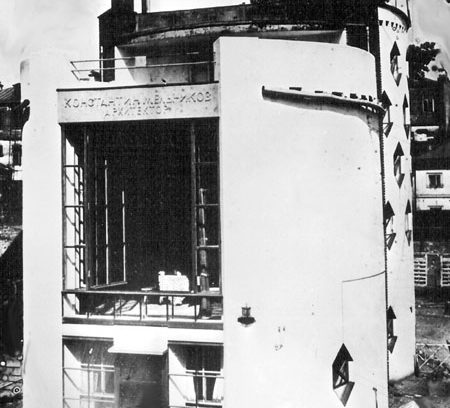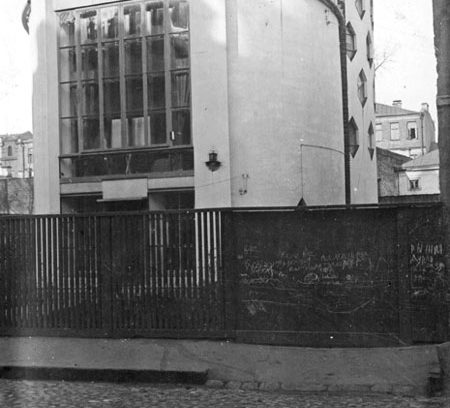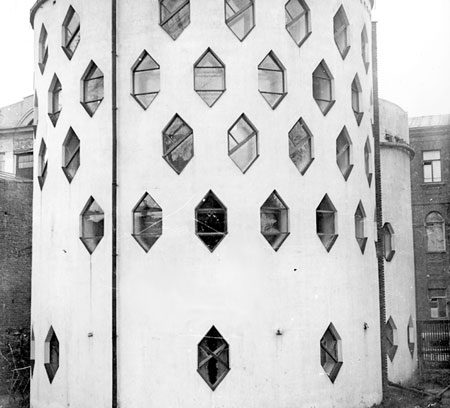This website uses cookies
This website uses cookies to enable it to function properly and to analyse how the website is used. Please click 'Close' to accept and continue using the website.





December 2005 - Melnikov House, Moscow
Melnikov House Studio 10 Krivoarbatsky Pereuolok, metro Smolenskaya (1927-1929)
Text by Clem Cecil and photographs courtesy the World Monuments Fund in Britain
“Ahead of its time and also behind it,” was the criticism levelled at Russian architect Konstantin Melnikov on the completion of his house, designed and built for himself in Moscow in 1929. This highly unusual building, made of two interlocking cylinders, has always been surrounded by paradox. Drawing on ancient peasant building techniques, and yet reminiscent of an American grain silo, the house has become a symbol of the Russian avant garde. It was one of the only private houses to be built during the Soviet regime in Moscow, and the land was granted to Melnikov thanks to a rare moment of cultural vision on behalf of the authorities.
Melnikov became an international star in 1925 when his Soviet pavilion won the Grand Prix at the Paris World Fair. This was not a time when individual success was smiled upon in the young Communist state, but despite this, Melnikov remained a devout Russian Orthodox, confident in his own talent, and emblazoned his name in plaster relief across the façade of the house.
Melnikov built many extraordinary buildings in Moscow in the twenties and early thirties, but it is to his own house that a path has been furrowed by a constant stream of visitors from all over the world. Viktor Melnikov, the architect’s son, continues to live there, and has created an informal house-museum to his father: the candles and some dried flowers from his parents wedding still stand before the icon in the downstairs parlour; his father’s paints and brushes are scattered across a desk in the upstairs studio. Melnikov’s archive of architectural drawings, paintings and writings lies stacked in the corners.
Although radical in appearance, and reminiscent of American grain silos, peasant building techniques were employed in the building of the house. Melnikov himself was from a peasant family and therefore familiar with such methods: the hexagonal walls that pierce the cylinders are redolent of the ramparts of fortresses, while the rough plastered brick texture of the inside walls are taken from church architecture. Also, according to Russian peasant traditions, the Melnikov family slept together in one room, divided by slender partitions. Such large internal spaces were possible thanks to innovative building techniques introduced by the architect such as self-reinforcing floors built from a waffle-like grid.
Despite the daring of the house, and the glorious sense of lightness in the interior, the house was attacked from the moment of its completion, and under the increasingly iron fist of Stalin in the 1930s Melnikov fell from favour and commissions dried up. The family continued to live in the house, with father and son painting in the studios and filling the house with delightful canvases.
The windows of the house were blown out during a bomb raid in the war and the family moved into the basement. Following Melnikov’s death in 1974 at the age of 84, the house has been barely maintained on Viktor’s pension and contributions from visitors. Restoration work undergone in the nineties brought some relief but also some damage to the house, and money is being sought for emergency repairs (an initial US $15,000). The house suffers from dry rot and the window frame on the central façade needs to be replaced as well as the roof, which is leaking.
The Melnikov House Studio is on the World Monuments Fund Watch List 2006 and is supported by The Moscow Architecture Preservation Society (MAPS), who are seeking funds for emergency repairs.
MAPS was set up in May 2004 following the destruction of three major Moscow landmarks. The Moskva Hotel and Voyentorg department store were demolished, and the Manezh partially destroyed in a fire. MAPS is run by a group of young architects, architectural historians, preservationists and journalists. They work closely with Russian and foreign preservationists and invite experts to advise on sustainable approaches to the historic built environment. They aim to convince the Moscow government, developers and architects that the demolition or poor restoration of Moscow’s old buildings is not in the city’s long-term interest.
For further information : www.wmf.org.uk or www.maps-moscow.com.
Clem Cecil (former Times Moscow correspondent) and Alexei Leporc (Hermitage) will be lecturing on ‘Moscow Under Threat’, at the Royal Geographical Society at 7pm on Thursday 23rd February 2006. Tickets £10/ £15 on 020 7730 5344.
Look for past Buildings of the Month by entering the name of an individual building or architect or browsing the drop down list.

Become a C20 member today and help save our modern design heritage.